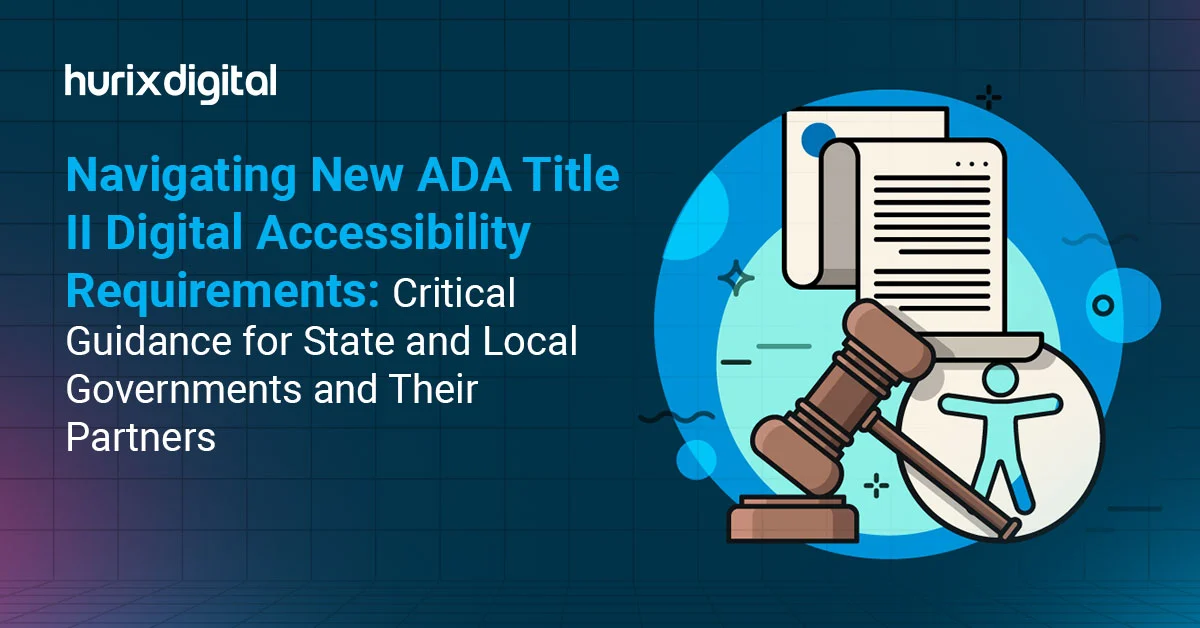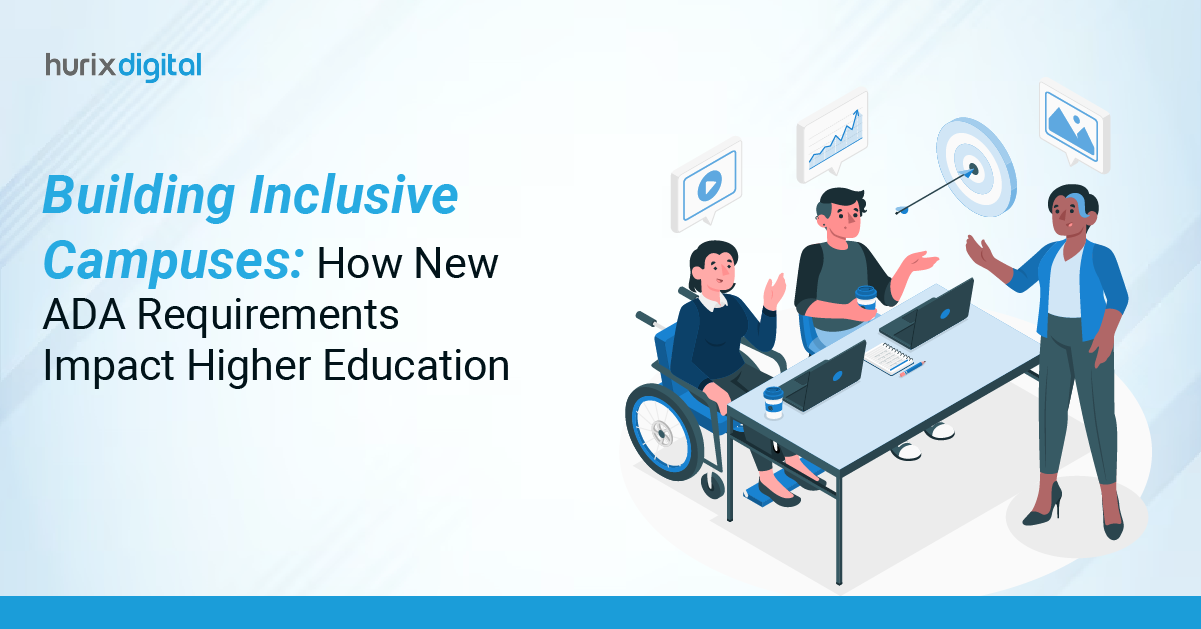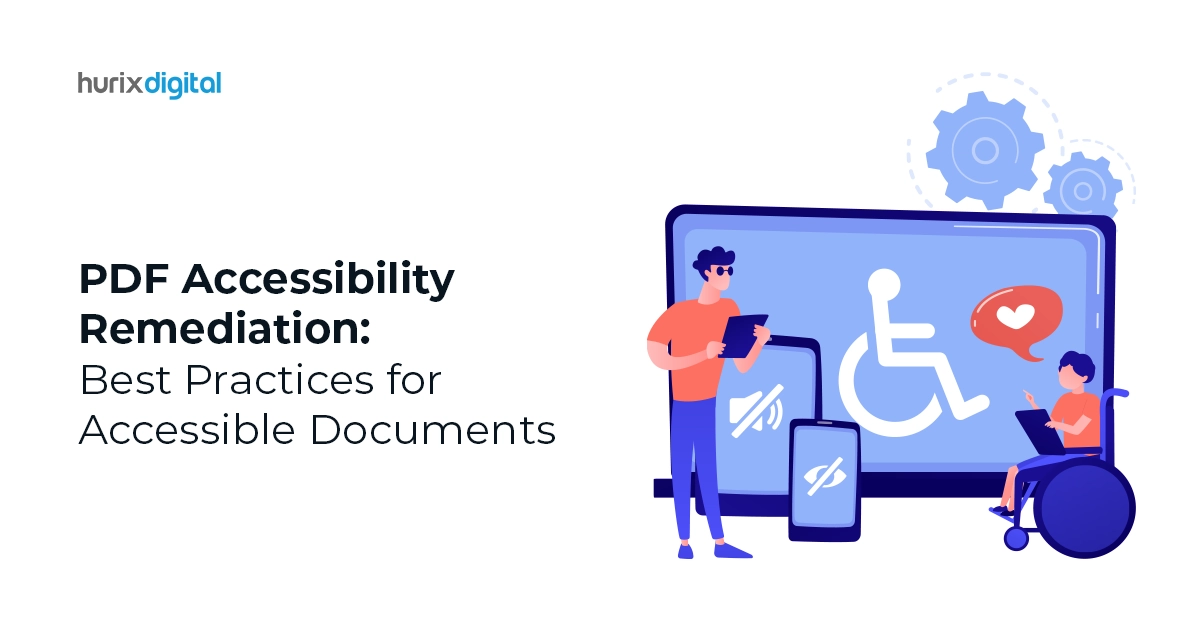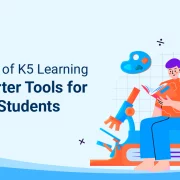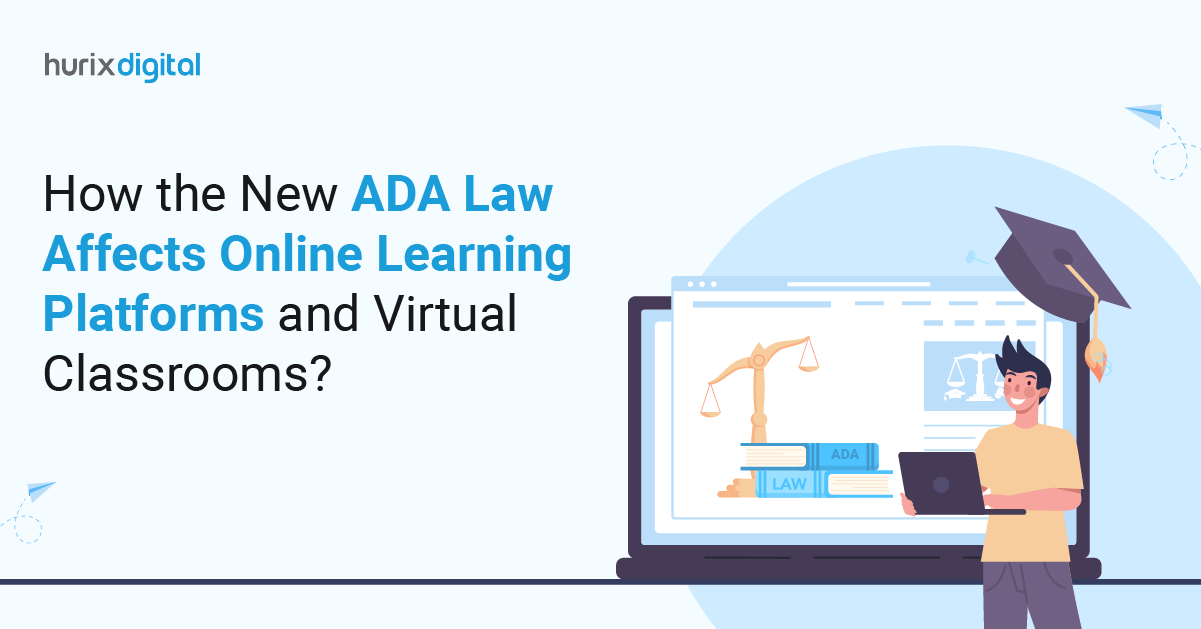
How the New ADA Law Affects Online Learning Platforms and Virtual Classrooms?
Summary
This blog discusses the ADA’s impact on digital accessibility in online learning, outlining key aspects and steps for compliance to create inclusive environments.
Established in 1990, the Americans with Disabilities Act (ADA) was a historic law meant to eradicate discrimination against people with disabilities. Although initially focused on physical locations such as public buildings, transit, and businesses, the rapid digital change has expanded the scope of ADA rules to include the online sphere.
The new ADA regulation emphasizes digital accessibility and is changing businesses, especially virtual classrooms and online learning environments. The law mandates that websites, digital materials, and online services be reachable to all users, including those with disabilities.
This change toward inclusivity has spurred significant dialogues on user experience (UX) enhancements, compliance tools, and accessibility audits. Creating accessible learning environments that suit different student groups must be a priority as educational institutions and EdTech systems change to meet the new ADA rules.
Table of Contents:
- The New ADA Law and Its Impact on Online Learning
- Key Aspects of the New ADA Law for Online Learning Platforms
- Conducting an Accessibility Audit for Compliance
- How the New ADA Law Enhances Digital Accessibility in Virtual Classrooms?
- Steps for Ensuring Compliance with the New ADA Law
- To Wrap Up
The New ADA Law and Its Impact on Online Learning
Driven by the COVID-19 epidemic and the growing need for flexible, remote learning solutions, online learning platforms have expanded rapidly in the last few years. But, the rapid spread of virtual classrooms has drawn attention to a crucial problem: student accessibility for disabilities.
Nowadays, the new ADA rule mandates that online learning systems satisfy strict accessibility criteria, which transcend conventional accommodations and center web accessibility.
The new ADA rules mandate that online platforms guarantee that their websites, applications, and content are reachable to every student, regardless of impairments. This covers those with visual, auditory, cognitive, and motor deficits. Ignoring these rules could lead to lawsuits, fines, and negative press for EdTech businesses and educational institutions.
Also Read: Accessibility and the Need for Closed Captioning in Educational Videos
Key Aspects of the New ADA Law for Online Learning Platforms
The new ADA regulation brings several important revisions that directly affect the functioning of online learning systems.
These changes stress the need to build easily available, user-friendly digital environments for every student. Every educational institution and EdTech platform has to take into account the following main aspects:
1. Web Content Accessibility Guidelines (WCAG)
The revised ADA statute closely conforms to the Web Content Accessibility Guidelines (WCAG), a body of internationally accepted standards for web accessibility.
These rules offer precise directions on how to make digital information accessible—that is, employing keyboard navigation, appropriate contrast ratios, alt text for photos, etc. Online learning environments have to follow WCAG 2.1 Level AA guidelines in order to meet the new ADA criteria.
2. Virtual Classrooms and Multimedia Content
The revised ADA rule emphasizes the ease of access to multimedia materials in virtual classes.
For students with hearing or visual disabilities, video lectures, recorded sessions, and live-streamed classes must have captions, transcripts, and audio descriptions. Assistive devices like screen readers should enable navigable interactive elements, including quizzes and polls.
3. Accessibility Audit
Conducting an accessibility audit is one of the most crucial actions online learning systems should take to guarantee adherence to the new ADA regulation.
Examining the accessibility of a website, platform, or application helps find obstacles that might keep people with impairments from completely accessing digital material. A comprehensive website accessibility audit typically assesses elements such as navigation, readability, keyboard functionality, and compatibility with assistive devices.
Conducting an Accessibility Audit for Compliance
Any effective digital accessibility plan starts with a careful access audit. By using such an audit, companies can find areas of non-compliance with the new ADA criteria and implement the required corrective action.
Conducting an accessibility audit calls for careful consideration of several fundamental elements:
1. Understanding Accessibility Audit UX
Accessibility audits should prioritize the user experience (UX) for people with impairments. This entails assessing users’ ease of navigating, interacting with, and understanding digital content.
By focusing on accessibility audit UX, organizations can ensure that online learning systems comply with regulations and offer an inclusive and positive learning experience for all users.
2. Utilizing Accessibility Audit Tools
Many tools for accessibility audits help companies review their digital materials. These instruments search platforms and websites for possible accessibility problems, such as non-functional keyboard navigation, poor contrast ratios, and missing alt text.
Among the well-known accessibility audit programs are Lighthouse, Axe, and WAVE, which create comprehensive web accessibility audit reports pointing to areas requiring work. These studies offer practical information that enables companies to reach ADA legal compliance.
3. Website Accessibility Audit Reports
Following an examination using an accessibility audit tool, organizations receive a web accessibility audit report that includes specific areas of concern. These reports are used to document accessibility problems, prioritize remedial actions, and demonstrate compliance progress.
A website accessibility audit report typically includes information on mistakes, cautions, and suggested practices for enhancing digital accessibility.
How the New ADA Law Enhances Digital Accessibility in Virtual Classrooms?
The new ADA rules mandate that educational institutions remove obstacles to learning, therefore promoting digital accessibility.
The following describes some ways the revised ADA statute improves digital accessibility in virtual classrooms:
1. Improved Navigation and Structure
With several tools, including discussion boards, video streams, and course materials, virtual classrooms can depend on sophisticated interfaces. The new ADA statute guarantees that every student—including those with assistive technologies—can use these platforms easily.
For instance, navigation menus should be reachable with keyboard commands, and screen readers ought to be able to read materials in a logical sequence.
2. Accessible Assessments
Online learning systems depend much on assessments; hence, the new ADA law mandates that interactive activities, tests, and quizzes be easily available.
This involves giving students choices to finish tests using other input techniques, such as voice instructions or keyboard-only navigation. Timed tests should also provide flexibility to students who require extra time because of a disability.
3. Inclusive Communication Tools
Live Q&A sessions, chat tools, and discussion boards abound in virtual classrooms. The revised ADA criteria guarantee that every student can use these communication tools.
This entails making sure chat boxes work for screen readers and captioning for real-time conversations. Teachers must also equip themselves to facilitate accessible communication in virtual environments.
Steps for Ensuring Compliance with the New ADA Law
Here are the steps you need to follow to ensure compliance with the new ADA law:
1. Conduct a Comprehensive Accessibility Audit
Doing a website accessibility audit with a reliable accessibility audit tool comes first. These instruments point up areas of non-compliance and create an online accessibility audit report detailing the necessary changes to satisfy ADA criteria. Regular audits ensure that institutions consistently check their systems for accessibility issues when introducing new content or features.
2. Implement ADA-Compliant Design Practices
Online learning systems must adhere to WCAG standards to comply with the new ADA requirements. This includes creating appropriate color contrast, ensuring keyboard navigability, and including alt text for images and descriptions of multimedia materials.
Platforms that focus on accessibility audit UX may provide easily navigable experiences that appeal to students using assistive technology.
3. Incorporate Accessibility in Course Content Creation
The platform’s accessibility is insufficient; the educational materials themselves must be ADA-compliant. Therefore, educators should instruct teachers on creating materials that are easily accessible, such as ensuring that PDFs are searchable, organizing text for screen readers, and providing subtitles for movies.
Institutions can incorporate accessibility checks into their content production processes to ensure that new materials meet accessibility criteria from the start.
4. Encourage Training and Awareness for Staff and Instructors
Knowing the value of accessibility and staying current with the new ADA law helps managers and teachers act early to ensure digital inclusiveness. To achieve this, we should teach the technical elements of accessibility and how to design an inclusive virtual classroom.
Also Read: 7 Tips on Creating a Seamless User Experience in Online Education Platforms
To Wrap Up
The new ADA rule has deeply impacted online learning systems and virtual classrooms, compelling them to integrate digital accessibility and prioritize inclusion.
Nowadays, compliance is a legal need that requires EdTech systems and educational institutions to provide website accessibility audit reports, use accessibility audit tools, and conduct extensive accessibility audits to ensure their platforms satisfy the new ADA criteria.
For organizations striving to meet these new requirements, Hurix Digital offers expert solutions to help you navigate the complexities of ADA compliance. Our comprehensive digital services include accessibility audits, compliance tools, and support for creating accessible content and platforms.
Contact us today to discover how we can help you achieve your accessibility goals and create an inclusive educational experience for all students!

Vice President – Digital Content Transformation. He is PMP, CSM, and CPACC certified and has 20+ years of experience in Project Management, Delivery Management, and managing the Offshore Development Centre (ODC).
